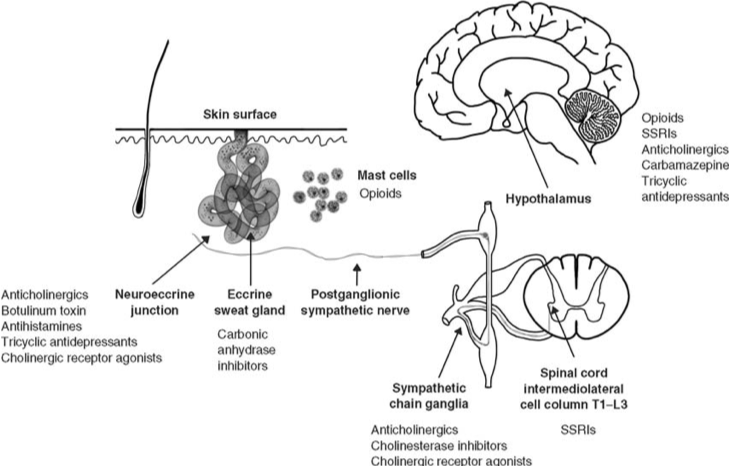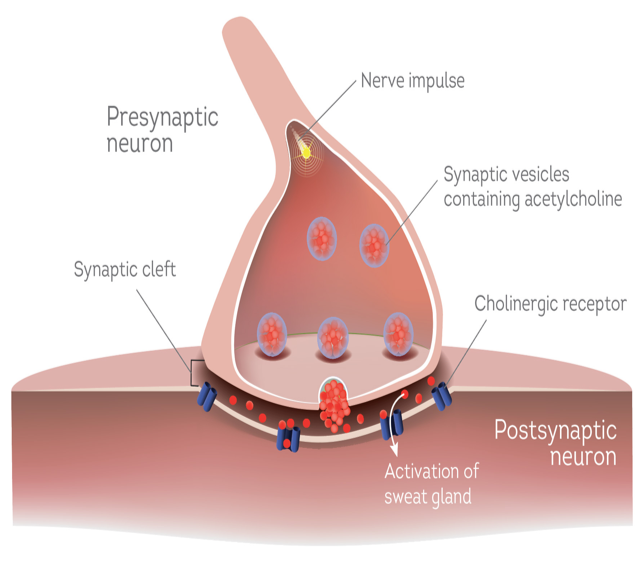Table of Contents
Sweating

Figure 1: Sweating.
Presentation Slides
What is sweating?
Sweating, also known as perspiration, is the release of fluids from sweat glands or the release of water by the skin and from the lungs (Folk & Semken, 1991). The two sweat glands that are involved in human perspiration are the apocrine and eccrine glands. Apocrine glands are typically found deep in the dermis, near hair follicles. These glands are concentrated in the axilla or armpit of humans but can be found scattered throughout the entire body as well. Apocrine glands produce viscous, somewhat oily secretions in typically less copious amounts compared to eccrine glands. Eccrine glands are found in the outer region of the dermis but are numerous on the palms and soles of humans. In contrast, eccrine glands produce dilute fluid in ample amounts (Folk & Semken, 1991).
Sweat Composition
The composition of sweat depends on the gland in which it was secreted from. Apocrine glands produce viscous, somewhat oily secretions in typically less copious amounts compared to eccrine glands. With a pH of 5.0-6.0 apocrine secretions tend to appear as a turbid, lactescent fluid (Shelley & Hurley, 1953). Apocrine glands tend to release proteins, lipids and steroids in their secretions as well. Eccrine glands secrete dilute, colourless fluid that is composed 99% of water. The majority of the remaining 1% consists of sodium chloride (NaCl), potassium (K), and bicarbonate. A minor portion of eccrine secretions contain glucose, pyruvate, lactate, cytokines, immunoglobulins, etc. (Bovell, 2015). As eccrine secretions contain a high concentration of NaCl, there are epithelial sodium channels (ENaCs) that reabsorb Na ions as excreted fluid evaporates, as a means to prevent the loss of Na+ (Hanukoglu et al., 2017). The pH of eccrine secretions can range from 4.0 to 6.0 (Shelley & Hurley, 1953).
Why do we sweat?
The main purpose of sweating is to aid in thermoregulation. It is made to prevent overheating of the human body (Folk & Semken, 1991). Changes in body temperature can be managed by various types of sweating.
Why do we turn red?
To prevent overheating, the hypothalamus signals blood vessels to dilate. In turn, the blood vessels will move closer to the surface of the skin, and this will allow heat to dissipate (Courseault, 2017). Ultimately, this process allows the body to cool down.
Evolution of Sweating
Before the eccrine system became the primary thermoregulatory system in humans, apocrine glands were once used as the primary producer of sweat. Apocrine glands were prominent in animals with thick fur coats and slow movement. Now, although they are still useful in regulating temperatures in modern humans, they are said to be vestigial (Folk & Semken, 1991).
Evolution of the eccrine system is said to have occurred around the same time as hairlessness and adoption of bipedal posture (Folk & Semken, 1991; Best & Kamilar, 2018), allowing for increased thermal sweating. Prior to eccrine gland evolution, human bodies became less efficient at dissipating heat as they became larger in size. In addition, as humans developed larger brains which are metabolically expensive, there became and increasing need for an improved thermoregulatory system (Best & Kamilar, 2018). It is suggested that eccrine gland evolution evolved to increase sweating for those living in hotter regions as well. Studies show that primates living in hotter climates have increased glycogen stores and a larger number of capillaries surrounding eccrine glands. These features would increase their sweating capacity as glucose is used for eccrine gland metabolism, and the larger number of capillaries would allow for increased oxygen transport, waste removal, water delivery, etc (Best & Kamilar, 2018). The development of an increased sweating capacity may have evolved at the same time the Homo genus foraged open savanna environments. Foraging during the day would be more convenient for foraging as there is a smaller chance of predators being present. Advanced eccrine glands would allow those to forage without succumbing to the effects of an overheated body (Best & Kamilar, 2018). Development of the eccrine glands is also suggested to help human regulate body temperature when participating in high intensity activities, especially when escaping predators. Running away from predators would also lead to production of copious amounts of sweat, especially when running in the heat (Best & Kamilar, 2018).
Types of Sweating
Diffusion of Water
This form of sweating is also known as insensible perspiration. Water diffuses from skin and lungs and allows for heat dissipation. This type of sweating occurs at all times. (Folk & Semken, 1991)
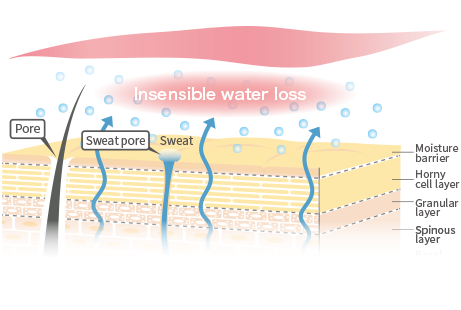
Figure 2: Insensible perspiration.
Thermoregulatory Sweating (Heat/Exercise)
Thermal sweating occurs when one is exposed to a high temperature environment or during muscular exercise. Both the high temperature environment and exercise cause an increase in body temperature. As a result, the body must have a way to reduce the temperature back to its normal level. Thus, heat-induced sweating occurs. The human body has millions of tiny eccrine sweat glands distributed across its skin which directly open to the skin surface (Cui & Schlessinger, 2015). The principle function of these eccrine glands is thermoregulation during exposure to hot environments or during physical exercise. They create a thermoregulatory organ which primarily secretes water that contains electrolytes. These glands allow humans to sweat up to 4 litres per hour in order to reduce body temperature and maintain homeostasis (Cui & Schlessinger, 2015).
Emotional Sweating
Emotional sweating is the physical reaction to stimuli such as anger, fear, pain, embarrassment, anxiety and emotional stress. Unlike thermoregulation, emotion, stress or other stimuli mainly stimulate sweat glands in the face, axillae (armpits), palms, and soles of the feet. The central pathway for emotional eccrine sweating is unclear, however evidence suggests that a center in the premotor cortex, and the amygdala of the limbic system are involved (Wilke et al., 2007). As well, emotional sweat is sometimes referred to as a “cold sweat”, as the release of sweat on the skin surface causes a decrease in body temperature. However, the sweat release is not stimulated by the thermoreceptors, so body temperature falls below homeostasis, giving the cold feeling (Roddie, 1977).
Additionally, emotional sweating in the axillary region does not begin until after puberty. This indicates that there is likely an essential role played by apocrine and apoeccrine glands, as they do not develop until the time of puberty. This explains the strong odour referred to as “body odour”. As apocrine secretions tend to have high levels of protein, bacteria living on skin are able to easily break the protein down. This reaction between the bacteria and sweat secretions is what produces body odour (Pandey & Kim, 2011).
Gustatory Sweating
The secretion of sweat can be induced by the consumption of certain foods as a result of direct or indirect thermal effects. Ingestion leads to increased metabolism, resulting in elevated body temperature and thermal sweating (Haxton, 1948).
Sweating due to Spicy Foods
Spicy foods can cause mild gustatory sweating in the face, scalp and neck areas. In spicy ingredients such as chili peppers, there are capsaicin molecules from the spicy food with attach to receptors found on heat-sensitive nerves. In other words, these capsaicin molecules stimulate the receptors that normally respond to heat. These receptors are called TRPV1. Once capsaicin attaches to TRPV1, a signal from the nerve is sent to the hypothalamus (Byrnes & Hayes, 2013). The signal leads the brain to believe that the body is experiencing a heat-related pain/overheating, and thus takes corrective measures to cool the body down—i.e. sweat glands will be activated to restore homeostasis.
The reason why some people cannot tolerate spicy food could be because their TRPV1 receptor proteins are more sensitive to capsaicin molecules (Byrnes & Hayes, 2013). Ultimately, they are more likely to feel a burning sensation than those with less sensitive TRPV1 receptors. Another reason could be because individuals are able to build a tolerance to spicy foods/capsaicin molecules. After repeated exposure to capsaicin, individuals would become desensitized and not feel much of a burning sensation compared to those who rarely eat spicy food.
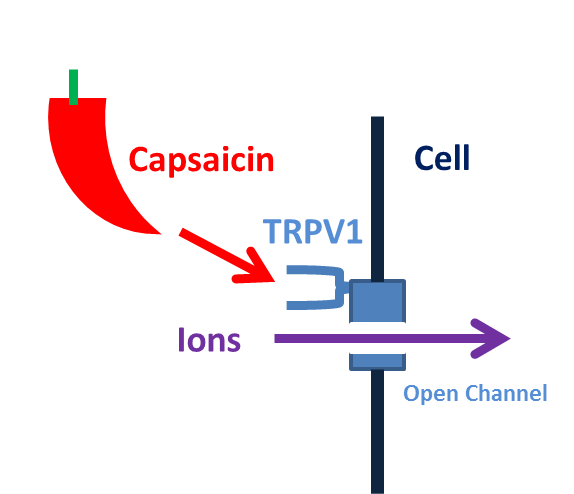
Figure 3: Stimulation of gustatory sweating due to spicy food.
Why Sweating is Good for you
Although sweating may seem gross or bothersome, causing stains on our clothing or producing bad smells, sweating is actually very good for us. Sweating is one of the ways in which our body releases toxins. In a study by Genuis et al., (2010) 10 healthy participants and 10 participants with health issues were observed to see which bodily fluid (urine, blood, or sweat) excretes the most toxic elements. It was found that the preferred route of excretion was through sweat. Arsenic, aluminum, copper, and mercury were among the metals tested these amounts were found far more in sweat than in urine. Induced sweating is a good way to naturally take out toxins from our body. Overtime, toxic elements bioaccumulate within our bodies and sweating excretes metals and metalloids that have built up under our skin. Exercise is a common way in which we sweat, besides the sweating for weight loss, sweating due to physical activity releases feel good hormones known as endorphins (Cohen et al., 2009). When endorphins are released, they give a sense of euphoria. When engaging in a type of physical activity with a group such as Zumba, hot yoga or rowing, higher levels of the hormone are seen more than when participating in physical activity alone (Cohen et al., 2009). Sweating has also been linked to lowering your chances of getting kidney stones. Kidney stone incidents have increased by 70% over the last 15 years and this is mostly seen in postmenopausal women (NY daily news, 2013). When we sweat we sweat out salt and retain calcium in our bones instead of the calcium going to our kidneys where stones are formed (NY daily news, 2013). This does not require rigorous sweating but mild to moderate is sufficient. Additionally sweating promotes thirst which will compel you to drink more fluids or more water thereby preventing stone formation. The best way to reap these benefits of sweating is to exercise regularly. Sweat produced from exercising encompasses all the benefits of sweating and more. Sweating via physical activity promotes weight loss, heart health and decreases the risk of developing harmful diseases all while excreting toxins and releasing feel-good hormones. Sweat is known to moisten skin, which can help in defense against parasites.
Why Sweating can be bad for you
Naturally, some people sweat more than others and typically overweight and out of shape people sweat more. However, over sweating also known as hyperhidrosis can cause dehydration and may also be a sign of thyroid problems, diabetes, or an infection (Doolittle et al. 2016). There are two types excessive sweating, localized or generalized. Localized hyperhidrosis is most common type of excessive sweating and does not mean that you have an illness (WebMD, 2011). It is characterized by over sweating in areas such as the armpit, feet, hands or forehead.The exact cause of this condition is unknown however researchers believe that it's due to a minor malfunction in the nervous system. Generalized hyperhidrosis is the least common type and is usually the cause of a medical issue such as menopause, thyroid issues, diabetes or pregnancy (Doolittle et al. 2016). This type of excessive sweating occurs all over the body.
Mechanism of Sweating
The primary thermoregulatory center is located within the preoptic hypothalamic regions of the brain. In humans, the neural pathways responsible for sweating are not entirely understood. However, based upon evidence from animal studies and human anatomical data, the neural pathway from the brain to sweat gland is believed to be as follows: First, efferent signals from the pre-optic hypothalamus travel via the tegmentum of the pons and the medullary raphe regions to the intermediolateral cell column of the spinal cord. In the spinal cord, neurons emerge from the ventral horn, pass through the white ramus communicans and then synapse in the sympathetic ganglia. Postganglionic non-myelinated C-fibers pass through the gray ramus communicans, combine with peripheral nerves and travel to sweat glands, with these nerve fibers wrapped around the periglandular tissue of the eccrine sweat gland. The sympathetic nerves distributed to sweat glands consist of large numbers of cholinergic terminals and a few adrenergic terminals. The effect of adrenergic terminals in causing sweating is minimal given that exogenous administration of adrenergic agents will cause only minimal sweating relative to acetylcholine (primary neurotransmitter causing sweating) administration. Administration of atropine (muscarinic cholinergic receptor antagonist) greatly attenuates or eliminates sweating during a resting state or cold temperature environment, confirming the dominance of the cholinergic system and muscarinic receptors in human sweating.
In addition to the central neural drive, sweating can also be initiated by an axon reflex. Exogenous administration of acetylcholine not only directly stimulates muscarinic cholinergic receptors on sweat glands, but also activates an axon reflex via stimulation of axonal nicotinic cholinergic receptors. The neural impulse due to the activated axon terminal travels through nerve terminals, resulting in the release of acetylcholine. Acetylcholine released from cholinergic nerves is rapidly hydrolyzed by acetylcholinesterase. Thus, acetylcholinesterase is capable of modulating sweat rate during low to moderate sweating activity.
The neurotransmitter(s) responsible for active cutaneous vasodilation has yet to be fully understood. However, neuropeptides such as calcitonin gene-related peptide (CGRP), vasoactive intestinal polypeptide (VIP), and substance P as well as nitric oxide (NO) have been implicated. All these neurotransmitters except substance P have been shown to increase sweat secretion. Even though acetylcholine is the primary neurotransmitter responsible for sweat secretion, enhanced sweating due to local administration of VIP, CGRP, or NO suggest that these peptides may contribute to the overall modulation of sweating during a thermal challenge as well.
When the eccrine sweat gland is stimulated, the cells secrete a fluid (primary secretion) via a family of membrane water channel proteins localized to the apical membrane of multiple secretory glands called Aquaporins (AQPs) (Crandall & Shibasaki, 2010). The primary secretion forms due to water with a high concentration of sodium and chloride ions and a low concentration of potassium ions being drawn from plasma in the interstitial space, which extract the fluid from the capillaries in the dermis. The proteins and fatty acids in the plasma remain in the interstitial space and don’t contribute to the formation of sweat. The primary secretion travels from the coiled portion of the gland up through the straight duct that connects to the opening/pore on the skin’s surface (AQP5). Activity in the straight duct depends upon the rate of sweat production or flow:
Low sweat production occurs during a resting state or in a cool temperature environment and results in a slight stimulation of the sweat gland. This allows for cells in the interstitial space to reabsorb most of the sodium and chloride ions from the fluid in the straight duct. As a result, a low volume of sweat that is concentrated in K+ and less concentrated in Na+ and Cl- gets secreted.
High sweat production occurs during an active state (exercise) or in a warm temperature environment and results in a strong stimulation of the sweat gland. As a result, cells in the interstitial space do not have enough time to reabsorb all the sodium and chloride from the primary secretion in the straight duct. Therefore, a high volume of sweat that is concentrated in Na+ and Cl- and less concentrated in K+ gets secreted.
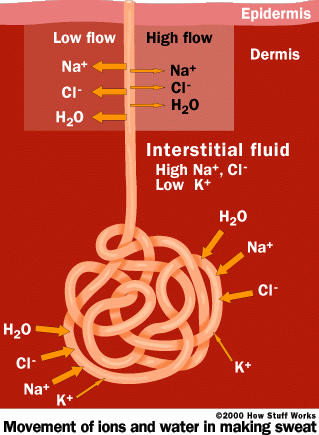
Figure 6. Movement of water and ions during the production of sweat.
Sweat in apocrine sweat glands is produced in the same way. However, the sweat from apocrine glands also contains the proteins and fatty acids from plasma, which makes the secretion thicker and gives it a milkier or yellowish color. This explains why underarm stains in clothing appear yellowish. Sweat itself has no odor, but when bacteria on the skin and hair metabolize the proteins and fatty acids found in sweat from apocrine sweat glands, they produce an unpleasant odor (Freudenrich, 2010).
Hormones
The secretion of hormones is a major factor in the human body’s regulation of sweat. The activation of periglandular cholinergic, α-adrenergic or β-adrenergic nerves leads lead to the production of sweat. The physiological effect of adrenergic receptors on sweating is questionable, however, cholinergic sweat secretion is the primary route, as it accounts for over 70% of the sweat capacity of the eccrine sweat glands (Cui & Schlessinger, 2015). Acetylcholine is a hormone secreted by sympathetic postganglionic neurons. Acetylcholine functions in eccrine glands through the receptor Chrm3 (Cholinergic Receptor Muscarinic 3) in order to stimulate the secretion of sweat. Chrm3 is expressed in myoepithelal cells and secretory cells, and blocking Chrm3 with specific antagonist’s leads to sweat secretion inhibition (Cui & Schlessinger, 2015). The activation of Chrm3 is regulated by the hormonal release of acetylcholine from the sympathetic postganglionic neurons, meaning that the primary route of sweat release is hormonally regulated by the sympathetic nervous system.
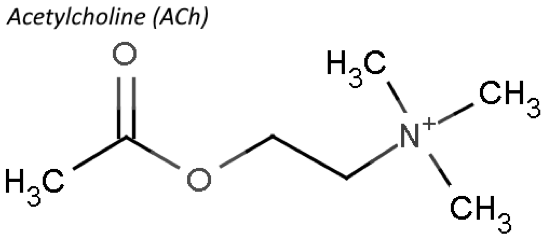
Figure 7: Structure of acetylcholine hormone.
Sweating in Animals
Cats and Dogs
Cats and dogs sweat in similar ways. The main source of sweating for dogs is panting and having their tongues stick out. By dogs panting, the water evaporates from their tongues, nasal passages and lungs (Goldbaum, 2016). Ultimately, this lowers their overall body temperature. Another way dogs sweat is through their paws. Likewise, cats also sweat through their paws. Although both these animals have sweat glands in their feet, there is a much larger surface area for panting which makes it more efficient (Goldbaum, 2016).
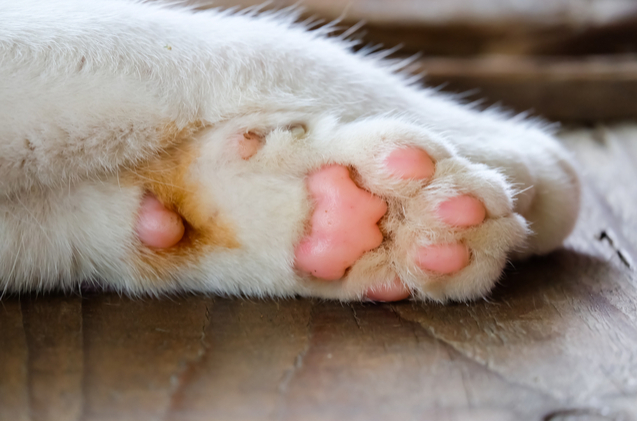
Figure 8: Cat paws that contain sweat glands.
Horses
The sweat of horses contains a chemical called latherin. This chemical is a natural detergent and functions to lather the body (Vance et al., 2013). According to researcher Malcolm Kennedy of the University of Gaslow, latherin's original function was found to be protein in saliva that helps with the breakdown of fibrous foods (Vance et al., 2013). Eventually, this chemical evolved to be expired during sweat. When this type of sweat is secreted in a horse, it spreads across the pelt to lower its body temperature (Vance et al., 2013).

Figure 9: Horse sweat which contains latherin (white substance).
Hippos
The sweat of hippos is a red oily substance. This substance prevents damage caused by the sun and helps cool them off (Seeker, 2016).
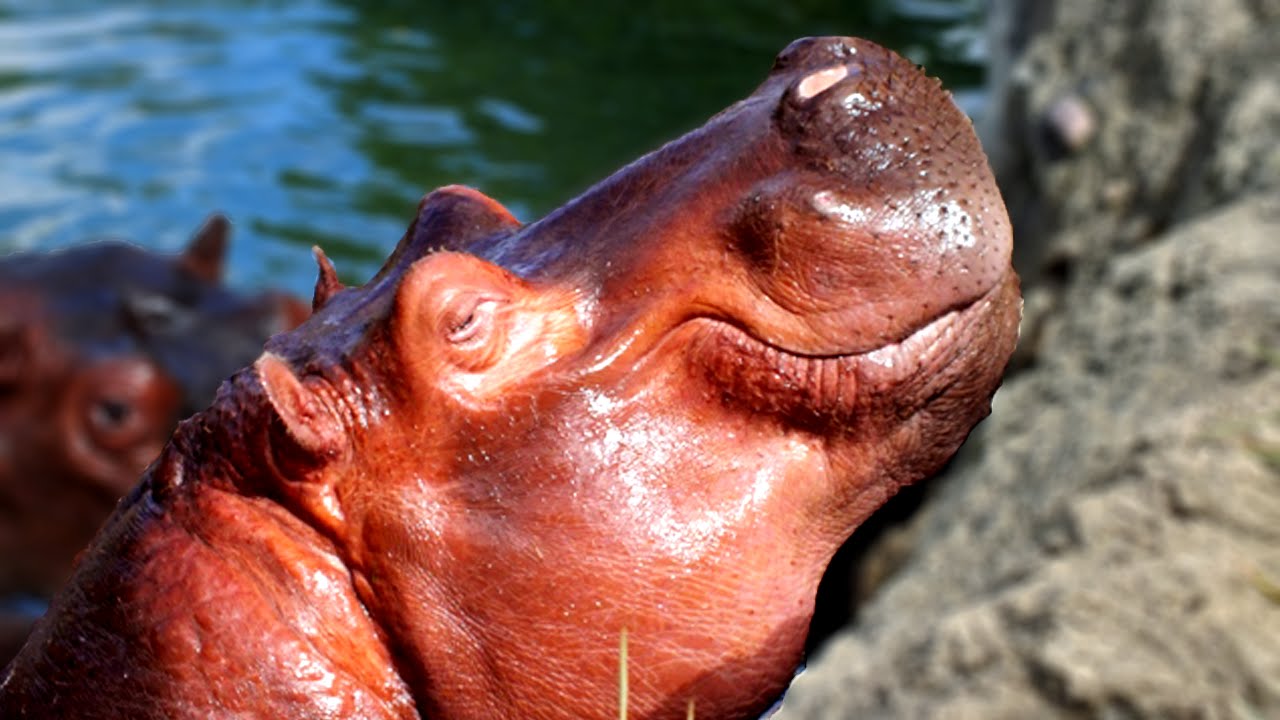
Figure 10: The red colour of hippos indicate their sweat.
Treatments for Excessive Sweating
Antiperspirant
Antiperspirants work to block perspire, like a plug. If people are finding they are still excessively sweating even while using antiperspirants, physicians can prescribe high-strength antiperspirants. The benefits of this treatment option are that it is non-invasive, relatively inexpensive to purchase, can be applied independently and readily accessible. One disadvantage of this method is difficulty in finding the most effective antiperspirant for each individual.
Oral Medications
Anxiety can be one of the major causes of stress. Taking a medication such as antidepressants can help to reduce the excessive sweating. Another family of medications that can be taken are anticholinergics. They work by trying to block acetylcholine as it tries to bind to receptors on the sweat glands that trigger sweating. Some of the benefits of this treatment option are that it targets the root cause of sweating and it is relatively easy to use independently. One reason as to why this medication may not be helpful is if people do not consider anxiety or mental illnesses itself to be the cause of their excessive sweating.
Botox Injections
These injections cause temporary relief by targeting and blocking the nerves that initiate sweating. Some of the benefits of this treatment plan are that you don't need to be treated very frequently (in comparison to oral medication and antiperspirant used every day). Some disadvantages are that this treatment is not a permanent solution and it is an invasive procedure.
Surgeries
In extreme cases, physicians may recommend surgery. The types of surgeries include sweat gland removal, nerve surgery and microwave therapy. One benefit to this method is that it is most likely a permanent solution to excessive sweating. However, this procedure can be expensive, invasive and can be preceded with a lengthly healing time.
References
Best, A., & Kamilar, J. M. (2018). The evolution of eccrine sweat glands in human and nonhuman primates. Journal of human evolution, 117, 33-43.
Blood, Urine, and Sweat (BUS) Study: Monitoring and Elimination of Bioaccumulated Toxic Elements | SpringerLink. (n.d.). Retrieved September 10, 2018, from https://link.springer.com/article/10.1007%2Fs00244-010-9611-5
Bovell, D. (2015). The human eccrine sweat gland: structure, function and disorders. Journal of Local and Global Health Science, 5.
Byrnes, N. K., & Hayes, J. E. (2013). Personality factors predict spicy food liking and intake. Food quality and preference, 28(1), 213-221.
Courseault, J. (2017, July 18). Why Do People Sweat When They Eat Spicy Foods? Retrieved from https://www.livestrong.com/article/501009-why-do-people-sweat-when-they-eat-spicy-foods/
Cui, C., & Schlessinger, D. (2015). Eccrine sweat gland development and sweat secretion. Experimental Dermatology, 24(9), 644-650.
Exercise prevents painful kidney stones in women over 50, large study finds - NY Daily News. (n.d.). Retrieved September 17, 2018, from /life-style/health/exercise-prevents-painful-kidney-stones-women-article-1.1334156
Folk, G. E., Semken, H. A. (1991). The evolution of sweat glands. International Journal of Biometeorology, 35(3), 180-186. doi: 10.1007/BF01049065
Griffin, R. M. (n.d.). Medical Causes of Excessive Sweating. Retrieved September 18, 2018, from https://www.webmd.com/skin-problems-and-treatments/features/is-your-excessive-sweating-caused-by-a-medical-problem
Hanukoglu, I., Boggula, V. R., Vaknine, H., Sharma, S., Kleyman, T., & Hanukoglu, A. (2017). Expression of epithelial sodium channel (ENaC) and CFTR in the human epidermis and epidermal appendages. Histochemistry and cell biology, 147(6), 733-748.
Harpin, V. A., & Rutter, N. (1982). Development of emotional sweating in the newborn infant. Archives of Disease in Childhood, 57(9), 691-695.
Haxton, H. A. (1948). Gustatory sweating. Brain, 71(1), 16-25.
Hornberger, J., Grimes, K., Naumann, M., Glaser, D. A., Lowe, N. J., Naver, H., … & Stolman, L. P. (2004). Recognition, diagnosis, and treatment of primary focal hyperhidrosis. Journal of the American Academy of Dermatology, 51(2), 274-286.
Hyperhidrosis: an update on prevalence and severity in the United States. (n.d.). Retrieved September 19, 2018, from https://www.ncbi.nlm.nih.gov/pmc/articles/PMC5099353/
Lear, W., Kessler, E., Solish, N., & Glaser, D. A. (2007). An epidemiological study of hyperhidrosis. Dermatologic Surgery, 33, S69-S75.
Kaufmann, H., Saadia, D., Polin, C., Hague, S., Singleton, A., & Singleton, A. (2003). Primary hyperhidrosis. Clinical Autonomic Research, 13(2), 96-98.
Kuno, Y. (1934). Physiology of human perspiration. J. And A. Churchill: London.
McSwiney, B. A. (1934). The composition of human perspiration. Proceedings of the Royal Society of Medicine, 27(7), 839-848.
Pandey, S. K., & Kim, K. H. (2011). Human body-odor components and their determination. TrAC Trends in Analytical Chemistry, 30(5), 784-796.
Roddie, I. C. (1977). Human responses to emotional stress. Irish Journal of Medical Science, 146(1), 395-417.
Rowers’ high: behavioural synchrony is correlated with elevated pain thresholds | Biology Letters. (n.d.). Retrieved September 12, 2018, from http://rsbl.royalsocietypublishing.org/content/early/2009/09/14/rsbl.2009.0670
Shelley, W. B., & Hurley Jr, H. J. (1953). The Physiology of the Human Axillary Apocrine Sweat Gland. Journal of Investigative Dermatology, 20(4), 285-297.
Wilke, K., Martin, A., Terstegen, L., & Biel, S. S. (2007). A short history of sweat gland biology. International Journal of Cosmetic Science, 29(3), 169-179.
Wörle, B., Rapprich, S., & Heckmann, M. (2007). Definition and treatment of primary hyperhidrosis. JDDG: Journal der Deutschen Dermatologischen Gesellschaft, 5(7), 625-628.
